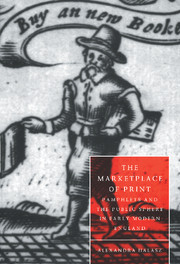5 - The public sphere and the marketplace
Published online by Cambridge University Press: 10 December 2009
Summary
The difference print makes
The classic or liberal public sphere is separated out of a larger private realm defined in opposition to the early modern state and its public authority.
Within the realm that was the preserve of private people we therefore distinguish again between private and public spheres. The private sphere comprised civil society in the narrower sense, that is to say, the realm of commodity exchange and social labor; imbedded in it was the family with its interior domain [“intimate sphere”]. (Habermas, Structural Transformation, 30)
By means of this simultaneous separation from the state, the marketplace, and the “intimate sphere,” the public sphere, as Habermas formulates it, can negotiate and express “the general interest” in a “rational” fashion (“Encyclopedia,” 53). In the first chapter I argued that the problem Habermas identifies as an incursion of commercial interests into the public sphere is present from the moment a public sphere becomes imaginable. Assessing that assertion and the arguments and evidence I have drawn from late sixteenth-century pamphlets requires closer attention to the ways in which Habermas describes the marketplace simultaneously as separate from the early public sphere and as its enabling condition. The “general interest,” he argues, was “guaranteed according to the presuppositions of a society of free commodity exchange, when the activities of private individuals were freed from social compulsion and from political pressure in the public sphere” (“Encyclopedia,” 53). The condition of formal or abstract equality in turn secures “the general interest” and, most important for Habermas, the possibility of a rational collective consensus within the public sphere.
- Type
- Chapter
- Information
- The Marketplace of PrintPamphlets and the Public Sphere in Early Modern England, pp. 162 - 203Publisher: Cambridge University PressPrint publication year: 1997



